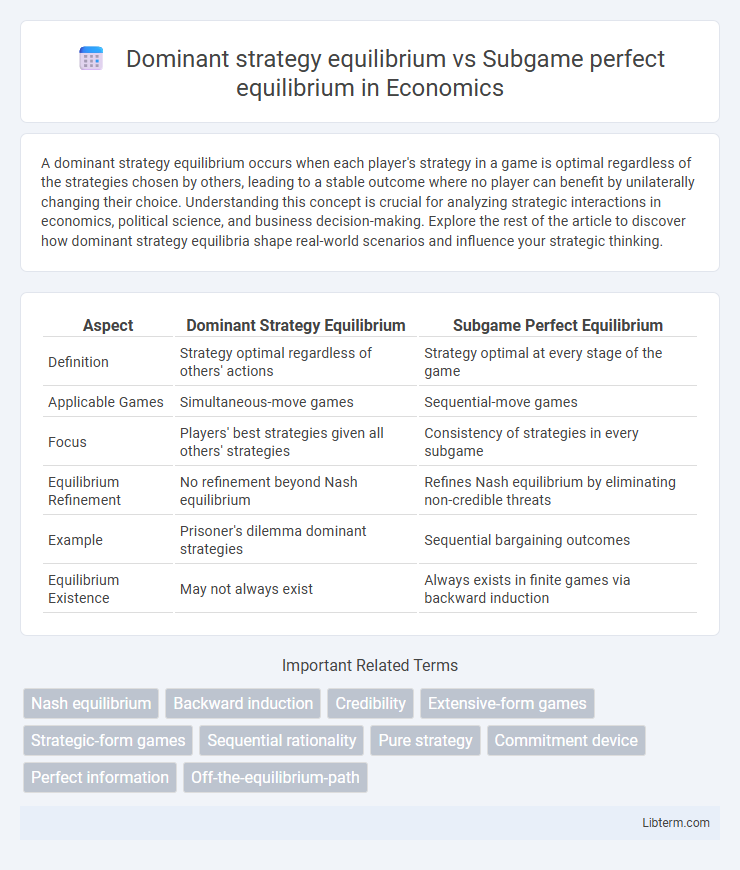A dominant strategy equilibrium occurs when each player's strategy in a game is optimal regardless of the strategies chosen by others, leading to a stable outcome where no player can benefit by unilaterally changing their choice. Understanding this concept is crucial for analyzing strategic interactions in economics, political science, and business decision-making. Explore the rest of the article to discover how dominant strategy equilibria shape real-world scenarios and influence your strategic thinking.
Table of Comparison
| Aspect | Dominant Strategy Equilibrium | Subgame Perfect Equilibrium |
|---|---|---|
| Definition | Strategy optimal regardless of others' actions | Strategy optimal at every stage of the game |
| Applicable Games | Simultaneous-move games | Sequential-move games |
| Focus | Players' best strategies given all others' strategies | Consistency of strategies in every subgame |
| Equilibrium Refinement | No refinement beyond Nash equilibrium | Refines Nash equilibrium by eliminating non-credible threats |
| Example | Prisoner's dilemma dominant strategies | Sequential bargaining outcomes |
| Equilibrium Existence | May not always exist | Always exists in finite games via backward induction |
Introduction to Game Theory Equilibria
Dominant strategy equilibrium occurs when a player's best strategy remains optimal regardless of the opponents' choices, ensuring consistent payoff maximization. Subgame perfect equilibrium refines Nash equilibrium by requiring strategies to constitute a Nash equilibrium in every subgame, thereby eliminating non-credible threats in dynamic games. Both concepts are fundamental in game theory equilibria, providing solutions for strategic decision-making under different game structures.
Defining Dominant Strategy Equilibrium
Dominant strategy equilibrium occurs in game theory when each player's chosen strategy is the best response regardless of the opponents' strategies, ensuring a stable outcome without incentives to deviate. This contrasts with subgame perfect equilibrium, which requires strategy profiles to constitute a Nash equilibrium in every subgame, refining predictions in dynamic or sequential games. Dominant strategy equilibrium simplifies strategic analysis by identifying choices that maximize individual payoffs unconditionally.
Understanding Subgame Perfect Equilibrium
Subgame Perfect Equilibrium (SPE) refines the concept of a dominant strategy equilibrium by requiring strategies to form a Nash equilibrium in every subgame of the original game, ensuring credibility and consistency across sequential decisions. SPE eliminates non-credible threats by enforcing optimal strategies at every stage, especially in dynamic games with sequential moves. Understanding SPE involves analyzing backward induction to determine strategies that remain optimal regardless of the game's history.
Key Differences Between the Two Equilibria
Dominant strategy equilibrium occurs when a player's best strategy is the same regardless of others' choices, ensuring optimality in all scenarios. Subgame perfect equilibrium refines this by requiring strategies to constitute a Nash equilibrium in every subgame, accounting for sequential rationality in dynamic games. The key difference lies in the domain of application: dominant strategy equilibrium applies universally across all possible actions of opponents, while subgame perfect equilibrium specifically addresses sequential games and eliminates non-credible threats.
Illustrative Examples: Dominant Strategy Equilibrium
A dominant strategy equilibrium occurs when each player chooses a strategy that yields the highest payoff regardless of the opponent's actions, such as in the Prisoner's Dilemma where defecting is dominant for both players. In this example, both prisoners defect, resulting in a Nash equilibrium that is also a dominant strategy equilibrium. This contrasts with subgame perfect equilibrium, which requires optimal strategies in every subgame rather than simple unconditional dominance.
Illustrative Examples: Subgame Perfect Equilibrium
In a sequential pricing game between two firms, the subgame perfect equilibrium (SPE) occurs when the leader sets a price anticipating the follower's optimal response, ensuring no player wants to deviate at any stage. For example, in an entry deterrence game, the incumbent firm sets a low price to deter entry, factoring in the potential entrant's rational decision to enter or stay out. Unlike dominant strategy equilibrium, which requires a single best strategy regardless of others' actions, SPE captures credible threats and promises within every subgame, leading to outcomes consistent with backward induction.
Applications in Real-World Scenarios
Dominant strategy equilibrium applies in auctions and voting systems where players' best strategies remain optimal regardless of others' actions, ensuring straightforward decision-making. Subgame perfect equilibrium is crucial in sequential bargaining, negotiations, and multi-stage games, guaranteeing credible strategies in every subgame and preventing non-credible threats. Both concepts enhance strategic decision processes in economics, political science, and business negotiations by improving predictability and stability of outcomes.
Strategic Implications for Decision-Makers
Dominant strategy equilibrium guarantees that a player's chosen strategy yields the highest payoff regardless of opponents' actions, simplifying decisions under uncertainty. Subgame perfect equilibrium refines this concept by ensuring optimal strategies in every stage of a dynamic game, eliminating non-credible threats. Decision-makers leveraging dominant strategies benefit from straightforward tactics, while those applying subgame perfection can anticipate future moves, enabling more credible and strategically sound commitments.
Limitations and Criticisms of Each Equilibrium
Dominant strategy equilibrium is often criticized for its overly restrictive assumption that players have a strategy that is best regardless of others' actions, which rarely holds true in complex, real-world scenarios. Subgame perfect equilibrium, while more refined by requiring credible threats in every subgame, can be computationally intensive and less predictive when players have incomplete information or when strategic interactions are not perfectly sequential. Both equilibria face limitations in capturing dynamic adjustments and bounded rationality found in practical strategic decision-making.
Conclusion: Choosing the Right Equilibrium Strategy
Selecting the appropriate equilibrium concept depends on the game's structure and strategic complexity; dominant strategy equilibrium offers simplicity when a single strategy outperforms others regardless of opponents' actions. Subgame perfect equilibrium provides a more refined solution by ensuring credibility and optimality in every subgame, crucial for dynamic games with sequential moves. Employing subgame perfect equilibrium enhances strategic predictability in extensive-form games, while dominant strategy equilibrium remains advantageous in static or simultaneous-move scenarios.
Dominant strategy equilibrium Infographic

 libterm.com
libterm.com